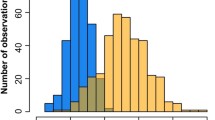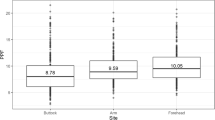Abstract
Ancestry informative markers (AIMs) are genetic loci showing alleles with large frequency differences between populations. AIMs can be used to estimate biogeographical ancestry at the level of the population, subgroup (e.g. cases and controls) and individual. Ancestry estimates at both the subgroup and individual level can be directly instructive regarding the genetics of the phenotypes that differ qualitatively or in frequency between populations. These estimates can provide a compelling foundation for the use of admixture mapping (AM) methods to identify the genes underlying these traits. We present details of a panel of 34 AIMs and demonstrate how such studies can proceed, by using skin pigmentation as a model phenotype. We have genotyped these markers in two population samples with primarily African ancestry, viz. African Americans from Washington D.C. and an African Caribbean sample from Britain, and in a sample of European Americans from Pennsylvania. In the two African population samples, we observed significant correlations between estimates of individual ancestry and skin pigmentation as measured by reflectometry (R2=0.21, P<0.0001 for the African-American sample and R2=0.16, P<0.0001 for the British African-Caribbean sample). These correlations confirm the validity of the ancestry estimates and also indicate the high level of population structure related to admixture, a level that characterizes these populations and that is detectable by using other tests to identify genetic structure. We have also applied two methods of admixture mapping to test for the effects of three candidate genes (TYR, OCA2, MC1R) on pigmentation. We show that TYR and OCA2 have measurable effects on skin pigmentation differences between the west African and west European parental populations. This work indicates that it is possible to estimate the individual ancestry of a person based on DNA analysis with a reasonable number of well-defined genetic markers. The implications and applications of ancestry estimates in biomedical research are discussed.




Similar content being viewed by others
References
Akey JM, Sosnoski D, Parra E, Dios S, Hiester K, Su B, Bonilla C, Jin L, Shriver MD (2001a) Melting curve analysis of SNPs (McSNP): a simple gel-free low-cost approach to SNP genotyping and DNA fragment analysis. Biotechniques 30:358–367
Akey JM, Wang H, Xiong M, Wu H, Liu W, Shriver MD, Jin L (2001b) Interaction between the melanocortin-1 receptor and P genes contributes to inter-individual variation in skin pigmentation phenotypes in a Tibetan population. Hum Genet 108:516–520
Barsh GS (1996) The genetics of pigmentation: from fancy genes to complex traits. Trends Genet 8:299–305
Bastiaens M, Huurne J ter, Gruis N, Bergman W, Westendorp R, Vermeer BJ, Bouwes Bavinck JN (2001a) The melanocortin-1-receptor gene is the major freckle gene. Hum Mol Genet 10:1701–1708
Bastiaens MT, Huurne JA ter, Kielich C, Gruis NA, Westendorp RG, Vermeer BJ, Bavinck JN, Leiden Skin Cancer Study Team (2001b) Melanocortin-1 receptor gene variants determine the risk of nonmelanoma skin cancer independently of fair skin and red hair. Am J Hum Genet 68:884–894
Brilliant MH (2001) The mouse p gene (pink-eyed dilution) and the human P gene, oculocutaneous albinism (OCA2) and melanosomal pH. Pigment Cell Res 14:86–93
Briscoe D, Stephens JC, O'Brien SJ (1994) Linkage disequilibrium in admixed populations: applications in gene mapping. J Hered 85:59–63
Byard PJ (1981) Quantitative genetics of human skin color. Yearb Phys Anthrop 24:123–137
Chakraborty R, Weiss KM (1988) Admixture as a tool for finding linked genes and detecting that difference from allelic association between loci. Proc Natl Acad Sci USA 85:9119–9123
Collins-Schramm HE, Phillips CM, Operario DJ, Lee JS, Weber JL, Hanson RL, Knowler WC, Cooper R, Li H, Seldin MF (2002) Ethnic-difference markers for use in mapping by admixture linage disequilibrium. Am J Hum Genet 70:737–750
Dean M, Stephens J C, Winkler C, Lomb DA, Ramsburg M, Boaze R, Stewart C, Charbonneau L, Goldman D, Albaugh BJ, Goedert JJ, Beasley RP, Hwang L-Y, Buchbinder S, Weedon M, Johnson P, Eichelberger M, O'Brien SJ (1994) Polymorphic admixture typing in human ethnic populations. Am J Hum Genet 55:788–808
Eaves IA, Merriman TR, Barber RA, Nutland S, Tuomilehto-Wolf E, Tuomilehto J, Cucca F, Todd JA (2000) The genetically isolated populations of Finland and Sardinia may not be a panacea for linkage disequilibrium mapping of common disease genes. Nat Genet 25:320–323
Flanagan N, Healy E, Ray A, Philips S, Todd C, Jackson IJ, Birch-Machin MA, Rees JL (2000) Pleiotropic effects of the melanocortin 1 receptor (MC1R) gene on human pigmentation. Hum Mol Genet 9:2531–2537
Hanis C L, Chakraborty R, Ferrell RE, Schull WJ (1986) Individual admixture estimates: disease associations and individual risk of diabetes and gallbladder disease among Mexican-Americans in Starr County, Texas. Am J Phys Anthropol 70:433–441
Healy E, Flannagan N, Ray A, Todd C, Jackson IJ, Matthews JN, Birch-Machin MA, Rees JL (2000) Melanocortin-1-receptor gene and sun sensitivity in individuals without red hair. Lancet 355:1072–1073
Jackson IJ (1997) Homologous pigmentation mutations in human, mouse and other model organisms. Hum Mol Genet 6:1613–1624
Jorde LB (2000) Linkage disequilibrium and the search for complex disease genes. Genome Res 10:1435–1444
Jorde LB, Watkins WS, Bamshad MJ, Dixon ME, Ricker CE, Seielstad MT, Batzer M (2000) The distribution of human genetic diversity: a comparison of mitochondrial, autosomal, and Y-chromosome data. Am J Hum Genet 66:979–988
Kaessmann H, Zollner S, Gustafsson AC, Wiebe V, Laan M, Lundeberg J, Uhlén M, Paabo S (2002) Extensive linkage disequilibrium in small human populations in Eurasia. Am J Hum Genet 70:673–685
Kanetsky PA, Swoyer J, Panossian S, Holmes R, Guerry D, Rebbeck TR (2002) A polymorphism in the Agouti signaling protein gene is associated with human pigmentation. Am J Hum Genet 70:770–775
Kennedy C, Huurne J ter, Berkhout M, Gruis N, Bastiaens M, Bergman W, Willemze R, Bavinck JN (2001) Melanocortin 1 receptor (MC1R) gene variants are associated with an increased risk for cutaneous melanoma which is largely independent of skin type and hair color. J Invest Dermatol 117:294–300
Kittles RA, Chen W, Panguluri RK, Ahaghotu C, Jackson A, Adebamowo CA, Griffin R, Williams T, Ukoli F, Adams-Campbell L, Kwagyan J, Isaacs W, Freeman V, Dunston GM (2002) CYP3A4-V and prostate cancer in African Americans: causal or confounding association because of population stratification? Hum Genetics 110:553–560
Lautenberger JA, Stephens JC, O'Brien SJ, Smith MW (2000) Significant admixture linkage disequilibrium across 30 cM around the FY locus in African Americans. Am J Hum Genet 66:969–978
Lewontin RC (1972) The apportionment of human diversity. In: Dobzhansky TH, Hecht MK, Steere WC (eds) Evolutionary biology, vol 6. Appleton-Century-Crofts, New York, pp 381–398
Long JC (1991) The genetic structure of admixed populations. Genetics 127:417–428
Long JC, Williams RC, Urbanek M (1995) An E-M algorithm and testing strategy for multiple-locus haplotypes. Am J Hum Genet 56:799–810
McKeigue PM (1998) Mapping genes that underlie ethnic differences in disease risk: methods for detecting linkage in admixed populations, by conditioning on parental admixture. Am J Hum Genet 63:241–251
McKeigue PM, Carpenter J, Parra EJ, Shriver MD (2000) Estimation of admixture and detection of linkage in admixed populations by a Bayesian approach: application to African-American populations. Ann Hum Genet 64:171–186
Nordborg M, Tavaré S (2002) Linkage disequilibrium: what history has to tell us. Trends Genet 18:83–90
Parra EJ, Marcini A, Akey J, Martinson J, Batzer MA, Cooper R, Forrester T, Allison DB, Deka R, Ferrell RE, Shriver MD (1998) Estimating African-American admixture proportions by use of population-specific alleles. Am J Hum Genet 63:1839–1851
Parra EJ, Kittles RA, Argyropoulos G, Pfaff CL, Hiester K, Bonilla C, Sylvester N, Parrish-Gause D, Garvey WT, Jin L, McKeigue PM, Kamboh MI, Ferrell RE, Pollitzer WS, Shriver MD (2001) Ancestral proportions and admixture dynamics in geographically defined African Americans living in South Carolina. Am J Phys Anthrop 114:18–29
Pfaff CL, Parra EJ, Bonilla C, Hiester K, McKeigue PM, Kamboh MI, Hutchinson RG, Ferrell RE, Boerwinkle E, Shriver MD (2001) Population structure in admixed populations: effect of admixture dynamics on the pattern of linkage disequilibrium. Am J Hum Genet 68:198–207
Pfaff CL, Kittles RA, Shriver MD (2002) Adjusting for population structure in admixed populations. Genet Epidemiol 22:196–201
Pritchard JK, Stephens M, Donelly P (2000) Inference of population structure using multilocus genotype data. Genetics 155:945–959
Rees JL, Birch-Machin M, Flanagan N, Healy E, Phillips S, Todd C (1999) Genetic studies of the human melanocortin-1 receptor. Ann N Y Acad Sci 885:134–42
Risch N, Merikangas K (1996) The future of genetic studies of complex human diseases. Science 273:1516–1517
Robins AH (1991) Biological perspectives on human pigmentation. Cambridge University Press, Cambridge
Shriver MD, Parra EJ (2000) Comparison of narrow-band reflectance spectroscopy and tristimulus colorimetry for measurements of skin and hair color in persons of different biological ancestry. Am J Phys Anthrop 112:17–27
Smith R, Healy E, Siddiqui S, Flanagan N, Steijlen PM, Rosdahl I, Jacques JP, Rogers S, Turner R, Jackson IJ, Birch-Machin MA, Rees JL (1998) Melanocortin 1 receptor variants in an Irish population. J Invest Dermatol 111:119–122
Smith MW, Lauternberger JA, Doo Shine H, Chreetien J, Shrestha S, Gilbert DA, O'Brien SJ (2001) Markers for mapping by admixture linkage disequilibrium in African-American and Hispanic populations. Am J Hum Genet 69:1080–1094
Spritz RA (1999) Multi-organellar disorders of pigmentation: intracellular traffic jams in mammals, flies and yeast. Trends Genet 15:337–340
Stephens JC, Briscoe D, O'Brien SJ (1994) Mapping by admixture linkage disequilibrium in human populations: limits and guidelines. Am J Hum Genet 55:809–824
Sturm RA, Teasdale RD, Box NF (2001) Human pigmentation genes: identification, structure and consequences of polymorphic variation. Gene 277:49–62
Taillon-Miller P, Bauer-Sardiña I, Saccone NL, Putzel J, Laitinen T, Cao A, Kere J, Pilia G, Rice J, Kwok P-Y (2000) Juxtaposed regions of extensive and minimal linkage disequilibrium in human Xq25 and Xq28. Nat Genet 25:324–328
Valverde P, Healy E, Jackson I, Rees JL, Thody AJ (1995) Variants of the meloancyte-stimulating hormone receptor gene are associated with red hair and fair skin in humans. Nat Genet 11:328–330
Valverde P, Healy E, Sikkink S, Haldane F, Thody AJ, Carothers A, Jackson IJ, Rees JL (1996) The Asp84Glu variant of the melanocortin 1 receptor (MC1R) is associated with melanoma. Hum Mol Genet 5:1663–1666
Wagner JK, Siccard C, Norton HL, Parra EJ, Shriver MD (2002) Skin responses to ultraviolet light: effects of constitutive pigmentation, sex, and ancestry. Pigment Cell Res (in press)
Wilson JF, Goldstein DB (2000) Consistent long-range linkage disequilibrium generated by admixture in a Bantu-Semitic hybrid population. Am J Hum Genet 67:926–935
Wright AF, Carothers AD, Pirastu M (1999) Population choice in mapping genes for complex diseases. Nat Genet 23:397–404
Wu H, Wang H, Li H, Akey J, Xiao F, Ke Y, Xu H, Xiao J, Lu D, Parra E, Shriver M, Xiong M, Barton SA, Hewett-Emmett D, Liu W, Jin L (2001) Skin reflectance in the Han Chinese and Tibetan populations. Hum Biol 73:461–466
Ye J, Parra EJ, Sosnoski D, Hiester K, Underhill P, Shriver MD (2002) Melting curve SNP (McSNP) genotyping: a useful approach to SNP genotyping in forensic science. J Forens Sci 47:593–600
Acknowledgments
We thank the volunteers who gave their time and DNA for this research, and Mark Jobling for assistance with sample preparation. We also acknowledge the support of the Penn State University General Clinical Research Center (M01 RR10732). This work was also supported in part by grants from the NIH/NHGRI (HG002154) to M.D.S., from NIH/NIMH (MH60343) to P.M.M., a Howard University New Faculty Award to R.A.K., and by the British Broadcasting Corporation to A.B.
Author information
Authors and Affiliations
Corresponding author
Additional information
Elecetronic database information: URLs for the data in this article are as follows:
dbSNP web page, http://www.ncbi.nlm.nih.gov/SNP/
Shriver Lab web page, http://anthro.psu.edu/rsrch/biolab/index.html
McKeigue Lab web site, http://www.lshtm.ac.uk/eph/eu/GeneticEpidemiologyGroup.htm
OMIM web site, http://www.ncbi.nlm.nih.gov/entrez/query.fcgi?db=OMIM
Rights and permissions
About this article
Cite this article
Shriver, M.D., Parra, E.J., Dios, S. et al. Skin pigmentation, biogeographical ancestry and admixture mapping. Hum Genet 112, 387–399 (2003). https://doi.org/10.1007/s00439-002-0896-y
Received:
Accepted:
Published:
Issue Date:
DOI: https://doi.org/10.1007/s00439-002-0896-y





